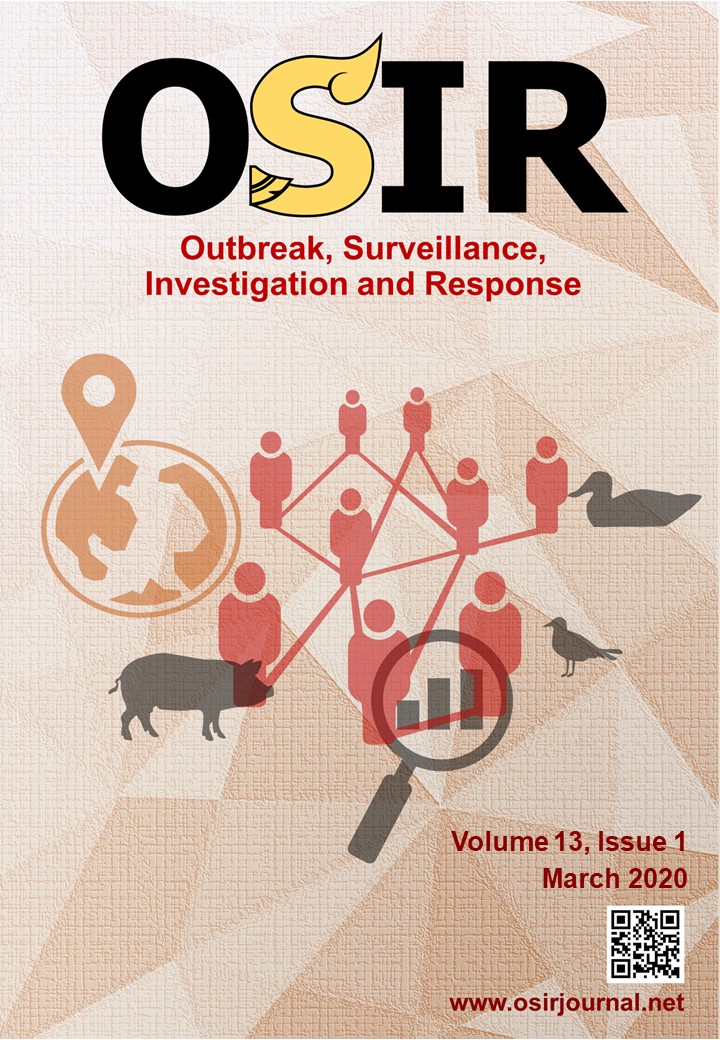Factors Associated with Knowledge and Practice of Healthcare Workers in Cervical Cancer Screening in Ratchaburi Province, Thailand
DOI:
https://doi.org/10.59096/osir.v13i1.262846Keywords:
cervical cancer, cancer screening, Papanicolau smearAbstract
Thailand’s 2010-2014 national program for cervical cancer screening guidelines recommends that women aged 30-60 years should be screened every five years with the Papanicolau smear (Pap smear) method or visual inspection with acetic acid and that coverage should be at least 80%. However, from 2010-2014, the national coverage of cervical cancer screening was only 53.9%. We therefore evaluated healthcare workers’ knowledge of the guidelines and their practices regarding cervical cancer screening by Pap smear. We collected data using a structured questionnaire from 258 healthcare workers who had ordered or conducted cervical cancer screening for at least one year. Most (74.8%) healthcare workers knew that Pap smears should be done every five years among women aged 30 to 60 years. General practitioners and gynecologists had lower knowledge of the age criteria compared to nurses and technicians. Knowledge of the target age criteria was significantly associated with type of healthcare worker, workplace, gender and recent training (within the previous 3 years). The screening practice was significantly associated with type of healthcare worker and workplace. Providing up-to-date training on the national cervical cancer screening guidelines is necessary for all public hospital healthcare workers.
References
National Cancer Institute, Thailand [homepage on the Internet]. Cancer in Thailand Vol. VIII, 2010-2012. [cited 2015 Oct 31]. <http://www.nci.go.th/th/File_download/Nci%20Cancer%20-Registry/Cancer%20in%20Thailand8.pdf>
Joseph R, Manosoontorn S, Petcharoen N, Sangrajrang S, Senkomago V, Saraiya M. Assessing cervical cancer screening coverage using a population-based behavioral risk factor survey—Thailand, 2010. Journal of Woman’s Health. 2015:24(12):966-968.
National Health Security Office [homepage on the Internet]. Bangkok: 5-year accomplishment: 7.6 million Thai women receiving cervical cancer screening [cited 2015 Oct 31]. <https://www.nhso.go.th/frontend/NewsInformationDetail.aspx?newsid=MTY0MA==>
Sirisamutr T, Butchon R, Putchong C, et al. The evaluation of outcomes and determinants of cervical cancer screening programme using Pap smear and visual inspection with acetic acid in Thailand during 2005 – 2009. Journal of Health Science. 2012 May - June:21(3):538-556.
National Cancer Institute [homepage on the Internet]. Bangkok: cervical cancer screening program in 75 provinces, 2010 [cited 2015 Oct 31]. <http://www.nci.go.th/cxscreening/download/pap%20project08022553.pdf>
National Cancer Institute [homepage on the Internet]. Bangkok: Guideline for cervical cancer screening, diagnosis and practice [cited 2015 Oct 31]. <http://www.nci.go.th/th/cpg/Cervical_Cancer.pdf>
Anantharaman W, Sudharshini S, Chitra A. A cross-sectional study on knowledge, attitude, and practice on cervical cancer and screening among female health care providers of Chennai Corporation 2013. Journal of Academy of Medical Sciences. 2012 Oct -Dec:2(4):124-128.
Kongputtikul K. The effectiveness of cervical cancer screening in women target groups by sub-district health personnel in contracting unit primary care network of Nongbualumphu maung district. Mahasarakham Hospital Journal.2010;7(3):1-9.
National Cancer Institute, Thailand (2017). Cervical Cancer Screening Program 76 provinces. <http://www.nci.go.th/cxscreening>
National Cancer Institute, Center for Diseases Control and Prevention, and Agency for Healthcare Research and Quality. The national survey of primary care physicians’ cancer screening recommendations and practices: Breast and cervical cancer screening questionnaire, OMB No. 0925-0562 [cited 2015 Oct 31]. <https://healthcaredelivery.cancer.gov/screening_rp/screening_rp_breast_cervical_inst.pdf?file=/surveys/screening_rp/screening_rp_breast_cervical_inst.pdf>
Al-Naggar RA, Low WY, Isa ZM. Knowledge and barriers towards cervical cancer screening among young women in Malaysia. Asian Pac J Cancer Prev. 2010;11(4):867-73.
Gamarra CJ, Paz EPA, Griep RH. Knowledge, attitudes, and practice related to Papanicolaou smear test among Argentina’s women. Rev Saude Publica.2005;39:270-6.
Nguyen TT, McPhee SJ, Nguyen T, et al (2002). Predictors of cervical Pap smear screening awareness, intention, and receipt among Vietnamese- American women. Am J Prev Med, 23, 207-14.
Wellensiek N, Moodley M, Moodley J, et al. Knowledge of cervical cancer screening and use of cervical screening facilities among women from various socioeconomic backgrounds in Durban, Kwazulu Natal, South Africa. Int J Gynecol Cancer.2002;12:376-2.
Mandelblatt JS, Yabroff KR. Breast and cervical cancer screening for older women: recommendations and challenges for the 21st century. J Am Med Womens Assoc.2000;55:210-5.
Austin L, Ahmad F, McNally M, et al. Breast and cervical cancer screening in hispanic women: a literature review using the health belief model. Womens Hlth Issues. 2002;12:122-8.
Wong LP, Wong YL, Low WY, et al. Knowledge and awareness of cervical cancer and screening among Malaysian women who have never had a Pap smear: A qualitative study. Singapore Med J.2009;50:49-53.
Downloads
Published
How to Cite
Issue
Section
License
Copyright (c) 2023 Outbreak, Surveillance, Investigation & Response (OSIR) Journal

This work is licensed under a Creative Commons Attribution-NonCommercial-NoDerivatives 4.0 International License.









